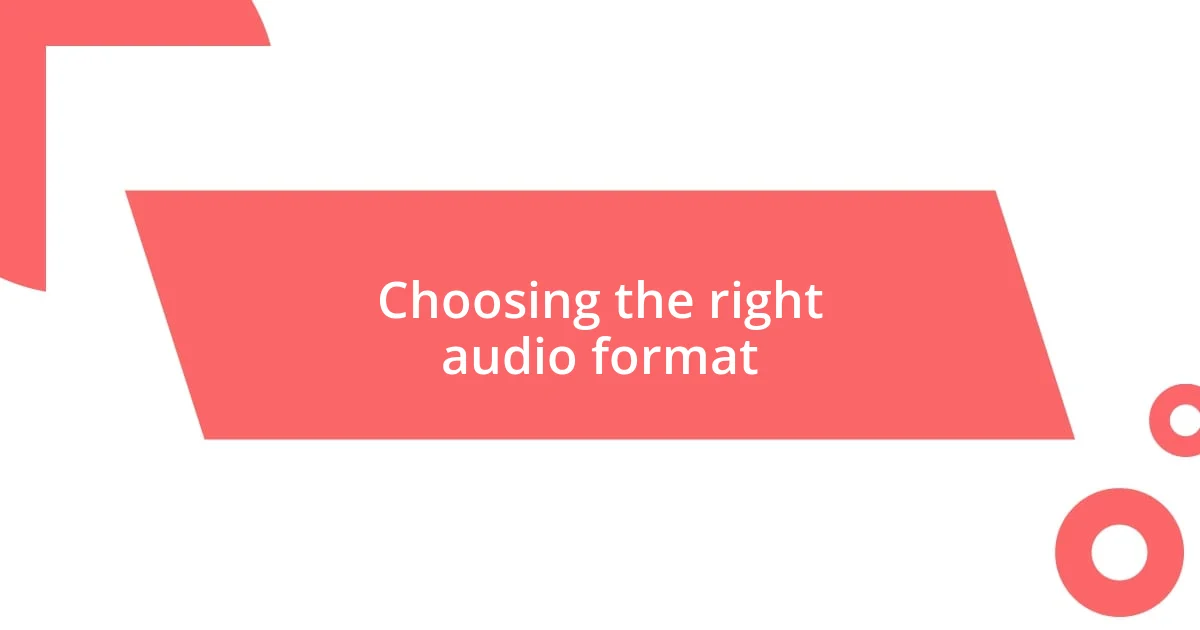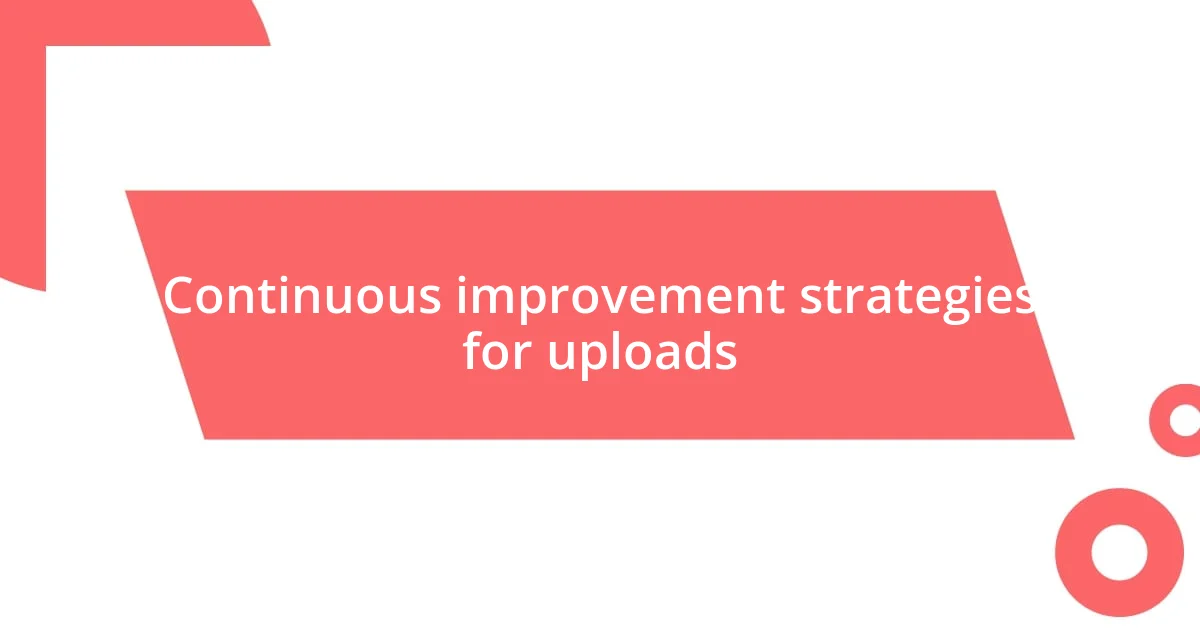Key takeaways:
- Research music upload platforms to find the best fit for your art, balancing exposure with costs.
- Optimize audio formats and metadata to enhance sound quality and improve discoverability of your tracks.
- Utilize social media effectively for promotion, focusing on engagement and consistency to build a supportive community around your music.

Understanding music upload platforms
When diving into the world of music upload platforms, it’s essential to recognize that each one has its unique strengths and weaknesses. I remember my first experience uploading music; I felt a mix of excitement and anxiety. I wondered, “Which platform will best showcase my art?”
Some platforms prioritize independent artists, offering greater exposure but may come with higher fees. It’s a balancing act; I had to weigh the potential of reaching a wider audience against the cost. During this journey, I discovered that understanding the specific demographic each platform caters to can significantly influence my music’s reach.
I often reflect on how important it is to research and compare these platforms thoroughly. Have you ever been overwhelmed by the options available? I certainly have. But after digging deeper, I found that knowledge truly is power—it gave me the confidence to make informed decisions that aligned with my vision.

Choosing the right audio format
Choosing the right audio format can feel like navigating a maze, especially with so many options out there. Based on my experience, I’ve found that lossless formats like WAV and FLAC preserve the original sound quality, which is crucial for my tracks. However, I once uploaded a single in MP3 format to save space, only to realize later how much richness was lost—something I couldn’t ignore during playback on my actual setup.
When deciding between formats, it’s essential to consider the platform’s requirements and the listening habits of your audience. I remember an online release where I initially used a lower bitrate. As a result, some fans commented on how they couldn’t fully enjoy the nuances in the sound. I quickly learned that choosing the right format isn’t just about storage; it’s about delivering the best experience to my listeners.
Here’s a simple comparison to help clarify the differences:
| Audio Format | Quality |
|---|---|
| WAV | Lossless |
| MP3 | Lossy (variable) |
| FLAC | Lossless |
| AAC | Lossy (better quality than MP3) |

Optimizing metadata for music uploads

Optimizing metadata for music uploads
Optimizing metadata is one of those behind-the-scenes tasks that can seem mundane but holds incredible power. I remember the first time I neglected to fill in my metadata completely; my music felt lost in the vast sea of uploads. Essential details like track title, artist name, and genre serve as lifebuoys for listeners navigating through countless songs. I found that taking my time to get it right not only helped my music surface more often but also painted a clearer picture for new listeners about the sound they can expect.
Here are some key elements to focus on when optimizing your metadata:
- Track Title: Be clear and engaging; it sets the stage.
- Artist Name: Use your stage name consistently for recognizability.
- Genre: Accurately classify your music; it aids discovery.
- Album Art: High-quality visuals catch the eye and communicate your style.
- Release Date: Important for cataloging and promotional efforts.
- ISRC Codes: These ensure proper tracking and royalties—don’t skip them!
With the right metadata, not only can you help your music stand out, but you get to share your artistic vision more effectively. I’ve learned that these seemingly small details can often lead to bigger opportunities down the line. It’s amazing how much clearer my musical narrative became when I paid attention to the specifics!

Creating engaging album artwork
Creating engaging album artwork is about more than just aesthetics; it’s the first impression of your sound. When I released my last project, I decided to create a cover that echoed the emotions in my music. I used vibrant colors and abstract shapes, reflecting the chaos and beauty of the songs. That visual connection sparked curiosity in potential listeners, and I’ve realized how impactful a good image can be in broadening your audience.
I’ve learned that simplicity can resonate just as much as complexity. A friend of mine, an artist, once shared a minimalist design he made for his EP, which ended up being the most memorable aspect of his release. Sometimes, less truly is more. I often ask myself: does this artwork tell a story that aligns with my message? If not, it’s back to the drawing board for me.
Using personal images can also make the artwork more relatable. For instance, I incorporated a photo from a memorable gig into my recent album cover. The sincere smiles and energy captured in that moment unarguably drew people in. Connecting with your audience through visuals can deepen their appreciation for your music, tapping into shared experiences and emotions. Ultimately, the goal is to ensure that your album artwork feels like a natural extension of your sound and message.

Utilizing social media for promotion
Social media has become an undeniable force in promoting music, and I’ve experienced its transformative power firsthand. I remember a time when I shared an upcoming track on my Instagram, posting a behind-the-scenes video of my recording process. The anticipation I felt as friends and fans engaged with my process was electrifying. With each comment and like, I realized that sharing snippets of my journey fostered a deeper connection with my audience. They weren’t just passive listeners; they became emotionally invested in my music.
Platforms like TikTok and Twitter have also been game-changers for quick promotions. I once jumped on a trending challenge that was somehow related to my music, and it skyrocketed my exposure. It made me think about how creativity plays a huge role—not just through the music itself, but in how you present it. I often ask myself, “How can I make my promotion feels like a conversation, not just an announcement?” When I crafted posts that felt authentic and reflected my personality, the engagement soared. Fans appreciate honesty and relatability, which reaffirms the notion that we’re all in this creative journey together.
Lastly, it’s essential to understand the value of timing and consistency in your posts. I learned this the hard way when I sporadically shared announcements, only to find that my audience had dwindled. Establishing a posting schedule not only kept my music fresh in their minds but built anticipation for each release. As I look back, it’s clear that utilizing social media effectively isn’t just about marketing—it’s about cultivating a community that grows with and supports your art. When I shared personal stories behind my songs, my followers felt more like friends cheering for my success rather than mere fans.

Analyzing upload performance metrics
Analyzing upload performance metrics is crucial for understanding how your music is being received. I remember checking the analytics after uploading a single, and I was surprised to see that certain songs received way more streams than others. I pondered: what was it about those tracks? Was it the time of day I released them, the accompanying promotional efforts, or perhaps the genre that resonated more with my listeners? Diving deep into those numbers helped me tailor my future uploads to what my audience truly craved.
I often found myself dissecting the geographical data of my listeners. For instance, I noticed a spike in streams from a particular region, which puzzled me at first. Upon reflection, I realized I had engaged with a local community on social media, sharing and collaborating with artists from that area. This revelation was enlightening; it taught me that my interactions outside of the upload process were feeding directly into my metrics. It made me think: how can I further cultivate those connections to enhance my reach?
Moreover, I began to pay close attention to listener retention rates. I noticed that certain segments of my tracks caused listeners to drop off. This prompted a shift in my songwriting approach, optimizing song length and structure to keep engagement high. After all, if I couldn’t keep their attention, how could I expect them to connect with my message? By continually analyzing these metrics, I’ve been able to refine my music and my strategy, ensuring each upload is more engaging than the last. It’s a dynamic process that really makes you think about the intersection of creativity and data.

Continuous improvement strategies for uploads
Finding ways to continuously improve my music uploads has been a journey of dedication and self-reflection. After every release, I’d often review what worked and what didn’t. I remember one time, I made a subtle change in the thumbnail for my music video after analyzing its impact. Instantly, the click-through rate improved, leading me to ask, “What other small tweaks can I implement that could make a big difference?”
Another strategy that proved invaluable was soliciting feedback directly from my audience. I began reaching out through polls on my social media, asking followers what they preferred in terms of content and format. This practice not only engaged my listeners but also made them feel included in my creative process. I realized that knowing what my fans loved gave me the confidence to take risks—like experimenting with different genres or release formats.
Additionally, staying updated on trends in music platforms has helped me refine my uploads significantly. I found out about features that I never knew existed, such as adding captions to my videos. Implementing these features not only made my music more accessible but also opened up new ways for listeners to interact with my content. Every upload became a chance to innovate, adapting to feedback and trends, which ultimately brought me closer to my audience while enhancing the overall quality of my music.















